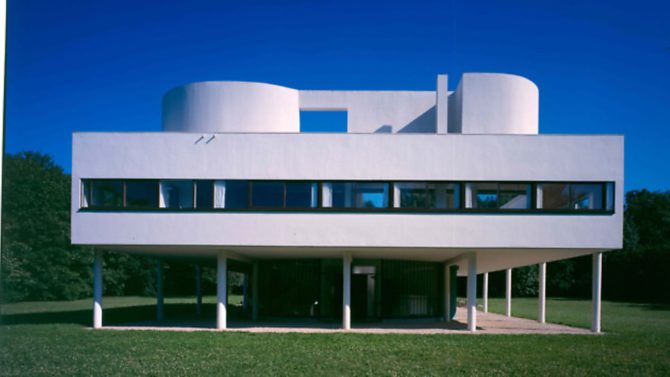Le Corbusier: Grand Designer

Le Corbusier was an architect who divided opinion. But his influence as a pioneer of modern architecture was undeniable and 17 of his works are now named as UNESCO World Heritage Sites

It’s perhaps appropriate that Le Corbusier, one of France’s greatest and most-divisive architects, believed in the possibility of reinventing oneself; he was not born with the name Le Corbusier, nor was he French by birth. Charles-Edouard Jeanneret was born in 1887 in La Chaux-de-Fonds in the Swiss Jura, a few kilometres from the French border. The son of a watch engraver, he enrolled at La-Chaux’s art school in 1900 and was taught by architect René Chapallaz, who influenced his early work.
Wanting to expand his horizons, he left for Italy in 1907 where a visit to a monastery, the Florence Charterhouse, ignited a belief that every man deserves to live well. The following year he visited Lyon, Strasbourg and Nancy, culminating the trip in Paris where he found work as a draughtsman for the architect and reinforced concrete pioneer Auguste Perret.
Read more: France’s UNESCO World Heritage Sites

After returning to La-Chaux in 1909 to oversee the building of two villas he’d designed while travelling, Jeanneret spent several years working in Germany and travelling around Eastern Europe. He returned to Paris in 1915 and two years later opened his own studio there. In 1919 he co-launched art magazine L’Esprit Nouveau with French Cubist Amédée Ozenfant. In the first issue, Jeanneret adopted the pseudonym Le Corbusier, adapted from his maternal grandfather’s name, Lecorbésier.
In 1922 he met Yvonne Gallis, a model from Monaco who would become his wife eight years later. In this year Le Corbusier exhibited in Paris a theoretical urban planning project entitled Ville Contemporaine. His imagined city would house three million people in 60-story glass skyscrapers with an airport at its core. Working in partnership with his cousin Pierre Jeanneret, he created houses for Parisian clients, many of which are located in the 16th arrondissement and the suburb of Boulogne-sur-Seine. One of them, Villa La Roche, now houses the Le Corbusier Foundation. He also received commissions for public housing, for example at Pessac near Bordeaux.
Read more: The life and work of Gustave Eiffel

Taking French citizenship in 1930, Le Corbusier continued to work on town planning theory in parallel with his architectural commissions. His 1926 Plan Voisin, which advocated razing parts of central Paris and replacing them with his sixty-story towers, was met with criticism. His 1935 paper La Ville Radieuse, lead to the creation of the groundbreaking Unité communal housing in Marseille in 1947, another was built in Nantes in 1965.
In 1937 the modernist designer was awarded the Chevalier de la Légion d’Honneur. He moved to Auvergne to work as a planner for the Vichy Government but returned to Paris in 1942 to re-open his studio. In the following years his work took him around the world, lecturing and designing. He consulted on the design of the United Nations Headquarters building in New York and advised governments on urban planning in countries such as Brazil and India. In 1950 he began one of his most iconic projects, the chapel at Ronchamp in Franche-Comté.

Le Corbusier drowned on 27 August 1967 while swimming in the Mediterranean at Roquebrune-Cap-Martin, where he often holidayed. It is thought he suffered a heart attack. With no heirs, he had spent the last period of his life planning a foundation to document his staggering body of work, which includes painting, sculpture, enamelling, tapestry, furniture, books, journals and papers in addition to houses, public buildings, churches, stadiums and even cities.
Le Corbusier buildings in France
La Chapelle de Notre-Dame du Haut
Created, according to Le Corbusier, as a place of “silence, prayer, peace, inner joy”, the stark modernist chapel in Franche-Comté has a concrete roof inspired by a crab shell. A further building on site by Renzo Piano, designer of the Pompidou Centre in Paris and London’s Shard, makes this a must for fans of contemporary architecture. If the scene’s not dramatic enough, the Vosges mountains make for an arresting backdrop.
Tel: (Fr) 3 84 20 65 13
www.collinenotredameduhaut.com
Le Corbusier Foundation
Discover more about the designer and see his drawings and plans in Villa La Roche, one of the sleek Parisian residences he designed early in his career. Built for Swiss banker and art collector Raoul La Roche, the villa is actually two buildings set at right angles to each other. Raised on concrete pilotis (stilts) with long strips of window panes, it’s classic Le Corbusier.
Tel: (Fr) 1 42 88 75 72
Roquebrune-Cap-Martin
The designer spent summers in the lush Mediterranean resort, staying in a tiny kitchenless cabin on the coastal path that he had made in Corsica as a gift for his wife Yvonne. The only dwelling he ever designed to inhabit himself, the cabanon was also where he spent his final hours. The couple are buried in the cemetery above the village.
Tel: (Fr) 4 93 35 62 87
La Cité Radieuse, Marseille
Take a guided tour to see an execution of Le Corbusier’s vision for urban communal living, Unité d’habitation. The concrete concept is a soaring village containing 337 apartments in 23 different designs. The rooftop has commanding views over the city and once had a running track and gym. Some Marseillans unkindly call it la Maison du fada, or house of lunatics; love it or hate it, you can’t deny its ambitious design.
Tel: 0826 500 500
Like this? You might also enjoy:
Famous French Figures: Louis XIV
The tragic life and death of Édith Piaf
Share to: Facebook Twitter LinkedIn Email


